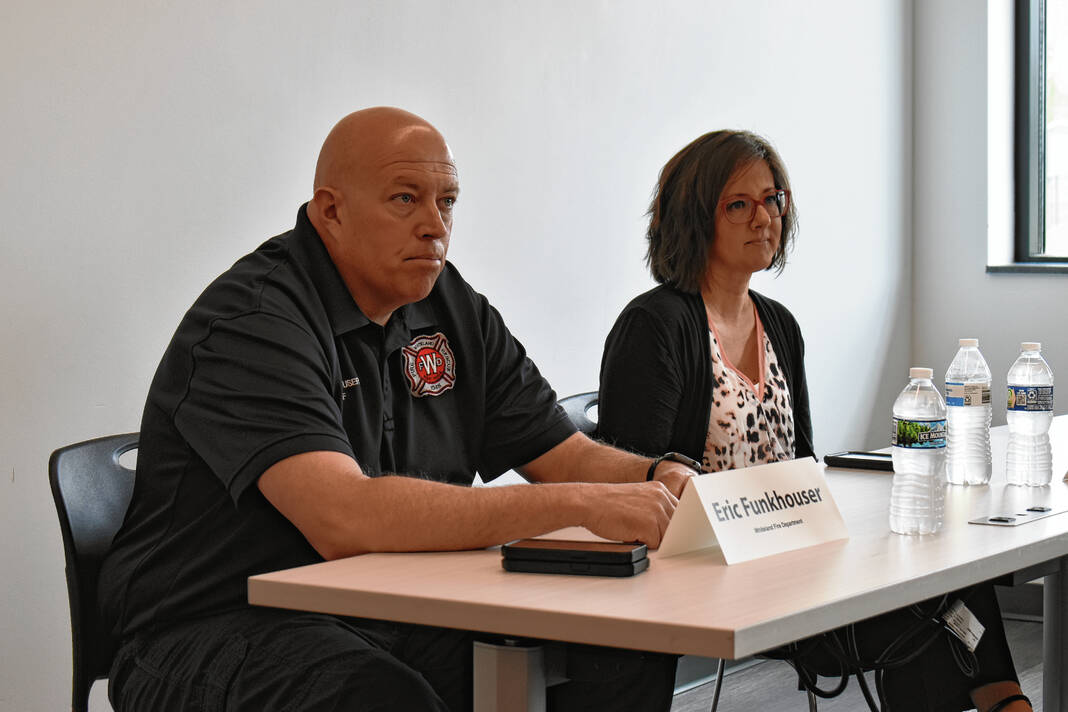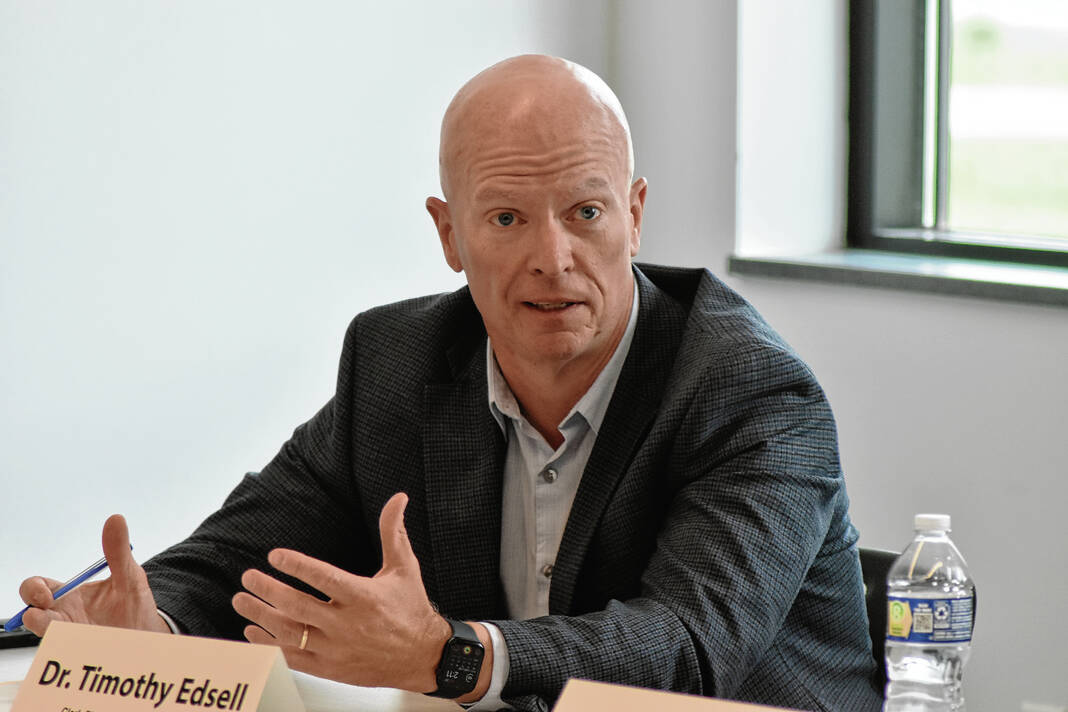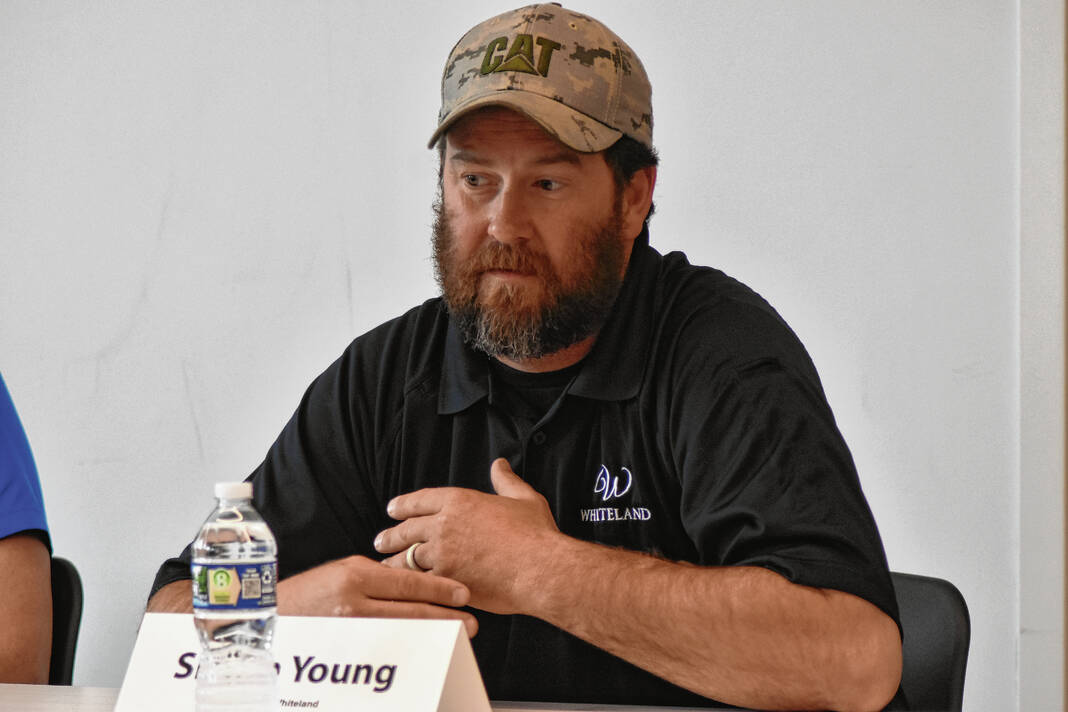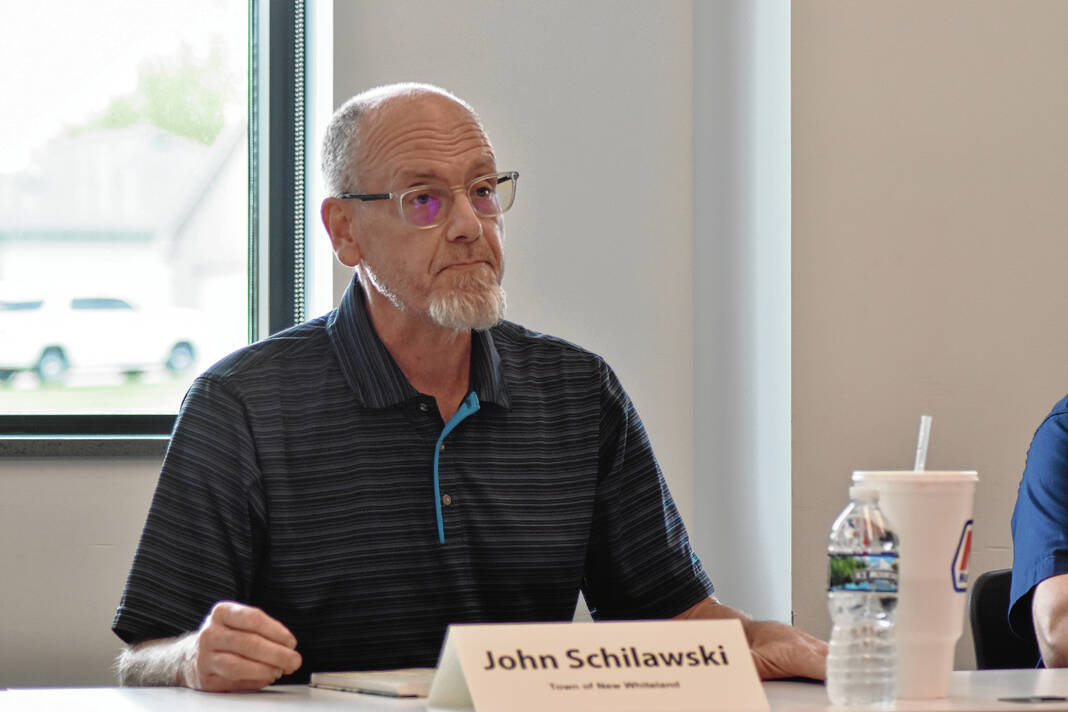
Police, fire, school and town leaders chat during a community conversation on public safety Saturday at the Clark Pleasant Library Branch in Whiteland. Noah Crenshaw | Daily Journal
At a roundtable discussion on public safety Saturday, two topics dominated the conversation — tornado recovery and evolving technologies.
Police and fire chiefs from Whiteland and New Whiteland, town leaders and Clark-Pleasant Community School Corp. officials gathered at the Clark Pleasant branch of the Johnson County Public Library to discuss public safety as part of the library’s Community Conversations series. They discussed Whiteland’s recovery from the tornado, technology changes, school safety, ways residents can improve public safety in their communities and more during the roughly hour-long discussion Saturday.
Tornado recovery
From the get-go, one of the first topics discussed was recovering from last year’s EF-3 tornado — a topic that came up again near the end of the discussion. The tornado’s aftermath led to a large amount of collaboration between different agencies, leading agencies to work better together for the future, said Eric Funkhouser, Whiteland fire chief.
The twister damaged the Whiteland Fire Station, causing the department to share space with New Whiteland until they brought in a temporary place to stay. This strengthened the bond between the departments, Funkhouser said.
One thing learned from the aftermath was how good some residents and business owners’ insurance policies were, and how others were not. It forced residents to look closely at their policies, said Carmen Young, Whiteland’s director of administration.
Officials found there were “quite a few” under-insured properties that were significantly impacted, which caused a lot of financial distress for residents as they tried to figure out their next steps. Town officials were able to help some of those cases, Young said.
Whiteland was also blessed to receive aid from the Federal Emergency Management Agency, as the March 2023 twister qualified for federal aid, she said.
While the federal aid was great, it did have an unexpected consequence. In the aftermath of the twister, the town was told by some contractors and vendors that they would be donating their services to help.
“As soon as FEMA was talked about, guess what? We got bills, and we had to pay those bills,” Young said. “Now, we got 75% reimbursed but … the town experienced some situations where we thought it was just folks wanting to do the right thing, and then we got a bill later.”
For example, the town has received over $100,000 in bills for dumpsters that people brought unprompted after the twister. Officials were grateful they were donating them, she said.
Then they received bills, Young said.
Officials learned that going forward, if someone says they are going to donate, they need to have them sign some documentation to hold up their end, Young said.
Changing technology
Technology has changed vastly in the last 25 years, including for public safety. When Funkhouser started, firefighters would have to come back to the firehouse after an incident and write paper reports.
Now it’s all on the computer, and each apparatus has rolling internet with them, he said. They can also see 911 dispatchers put in the run information in real-time, whereas before they’d have to wait for someone to take the call, write it down, and then call them to get going, Funkhouser said.
“It’s even cut down on our response times,” Funkhouser said.
As for equipment, it has vastly improved too. They now have masks where firefighters can see thermal imaging while wearing them — though the batteries die quickly, he said.
New Whiteland’s Fire Department recently purchased a LUCAS device, which is used for CPR in cardiac arrest situations. The device can be strapped on a patient and automatically do chest compressions, said Dave Curin, New Whiteland fire chief.
While the equipment is expensive, the advantage is that it gives consistent, perfect compressions every time — increasing patient survival rates dramatically, Curin said. It was paid for with funds from the American Rescue Plan Act, said John Schilwaksi, a New Whiteland Town Council member.
Schilwaski also highlighted the benefits of receiving federal funds like ARPA. New Whiteland wouldn’t have been able to pay for something like the LUCAS device without that aid, he said.
“We don’t have a lot of money,” Schilwaski said. “But when you get something like this that you didn’t even ask for, we use it responsibly. [We’re] good stewards of the money that we get.”
School safety
Cameras are important in schools, as they can serve a reactive role when investigating a vandalism issue for example. School safety technology helps officials receive and break down information faster, and communicate with the public faster as well, said Tim Edsell, the superintendent of Clark-Pleasant Community School Corp.
Cameras have also become more “intelligent.” In the past, they were something that was just placed and people had to review footage to find something, but now they communicate with each other and can notice when something is off, said Chad Pryce, chief of police for the Clark-Pleasant Police Department.
“We could put feed trackers on where if somebody enters a restricted area, it alerts us. We get alerts now to all of our phones,” Pryce said. “So like just the technology working for us, rather than us working with technology, has come light-years from where it’s been just in three years.”
Edsell also briefly touched on artificial intelligence, saying it’s mind-blowing how it can be used not just in the classroom, but in ways to improve school safety.
Both Edsell and Pryce were asked about how they could get background information from students transferring in from Marion County. CPPD has a great working relationship with school agencies in Marion County for the most part, but they can’t do background searches on each kid that comes into the school, Pryce said.
It is common practice to share records, but it’s not the law. Some schools are more willing to share records than others, which can make it challenging, Edsell said.
Improving public safety
Near the end of the conversation, officials were asked about the ways residents could help improve public safety. One way is simple — calling the police when issues arise.
“I understand a lot of times they want to stay anonymous, and there are some things they want to get involved because they’re afraid,” said Joe Rynerson, New Whiteland police chief. “But I think a lot of times if they can just call us anonymously … if they would do that, I think that that would help better the community as a whole.”
While residents do communicate with officers, getting over this hurdle would improve public safety further, he said.
Sometimes Rynerson has even heard from people saying they didn’t want to bother calling because it might be “stupid.” However, it could be the missing link to help solve a crime, he said.
On the fire side, Curin says they train responders to look around homes to see if there’s anything they can help them with and address hazards homeowners might not even realize are there. Typical problems include tripping hazards, improper use of extension cords and helping them identify a clear path for escape if there is a fire, he said.
With social media, there is a lot of times misinformation about what towns are doing. Young encourages people to call the department or town directly to find out what’s going on, she said.














